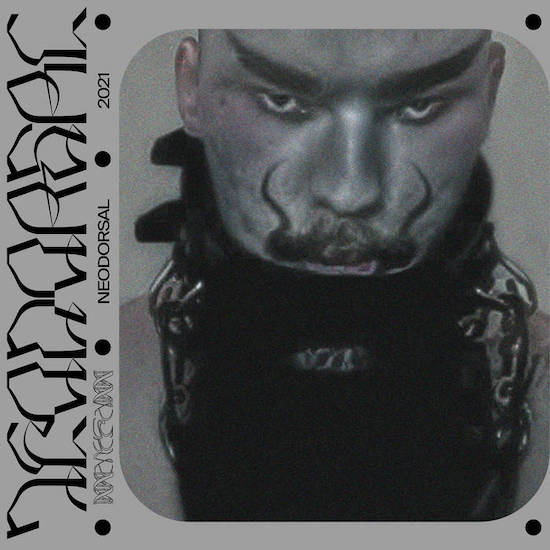When listening to the music created by Myen, the first thing that strikes you is how stark it all sounds. There isn’t much warmth going on. The project was conceived as a way to deal with the discomfort that comes with bowel disease. The music is meant to act as a sonic ritual. Guttural vocals feature heavily, but are manipulated to create an artificial voice, which the album takes its name from. ‘Neodorsal’ is also a fictional term created by Myen to describe the painted vocal sounds that they utilise, and explore, throughout their debut album.
‘Ace’ is a series of electronic surges, samples of laughter, and chopped-up basslines. Are the laughs aimed at us for what we are about to experience or an expression of the glee that Myen had crafting the album? I’m not sure, but it does put the listener on the back foot from the beginning, constantly trying to work it out.
‘Gut Healer’ starts the album off proper. Distressed strings and deep electronic hum are pretty much all that is on offer for three-and-a-half minutes. It’s terse but there is a pleasure to the conflicting sounds, and tones. Following that, ‘Bevel Kia’ positions the album’s catchiest melody under skittering synths. At times it reminds me of early Burial, but without the beats. It is also the tenderest track on the album. Serene synths drift about lazily, like smoke listlessly hanging above an ashtray on a summer’s afternoon. The sheer simplicity of ‘Bevel Kia’ takes you back. You are waiting for it all to kick off, but this never happens, instead we are given something that lingers long after the song, and album, finishes.
There is a lot going on throughout ‘Ember’ (featuring Berlin-based Cuban-German artist, Réelle). It starts off sounding like the sound effect from a 90s beat ’em up computer game. The sound of synthetic punches, blocks, and groans, dominate. Then, about a third in, a barrage of beats explodes from the speakers. This moment is short lived, as what sounds like a string section warming up comes to the fore and gracefully closes the song.
There are times during Neodorsal when it’s hard to work out what you are listening to. ‘Cleft Lip’ is made up of a series of piercing drones, electronic blips, and groaning synths. There is no real melody going on – or rhythm, for that matter. During ‘Alabaster’ you almost expect Myen to finally drop a devastating bassline, or hulking breakbeat, like a payoff for the previous twelve tracks of audio subterfuge. But they don’t and the album is better for it. At high volumes, it was quite painful to listen to. At times I questioned what I was doing listening to it, or if it was actually enjoyable. But I kept listening. There was something compelling into the music. The fact that I wasn’t sure what was going to happen next, made me want to keep listening to find out. Even after a third, or sixth listen I was still taken aback by what I was listening to. This is why Neodorsal is such a captivating listen.
There are sections of Neodorsal that make me smile and wince in equal measure. Myen seems to be asking questions about what electronic music should and could be in 2021. Their answers, like the music itself, is abrasive and abstract. And this seems to be the point of Neodorsal. To push themselves, as well as us, into new and exciting places. This is to be commended. However, there are times when you’d rather Myen just deliver a banger before getting back to the audio abstractions. The fact that they never do might just be the masterstroke of the whole album.


